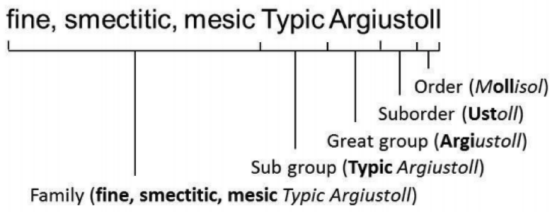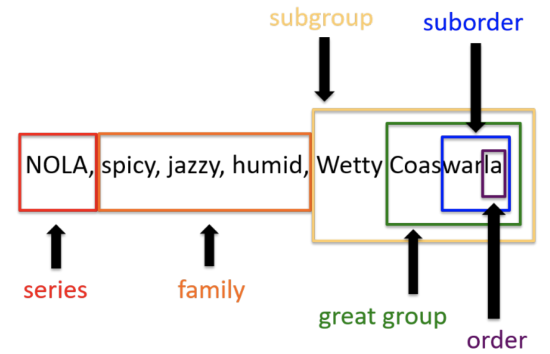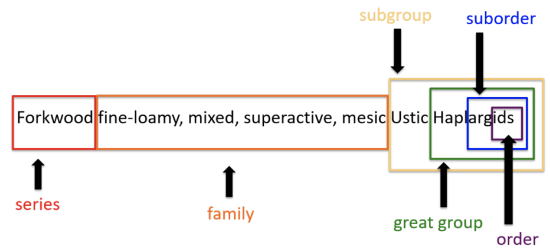3.2: Pre-Class Activity- Classified Location Exercise
- Page ID
- 14442
\( \newcommand{\vecs}[1]{\overset { \scriptstyle \rightharpoonup} {\mathbf{#1}} } \)
\( \newcommand{\vecd}[1]{\overset{-\!-\!\rightharpoonup}{\vphantom{a}\smash {#1}}} \)
\( \newcommand{\id}{\mathrm{id}}\) \( \newcommand{\Span}{\mathrm{span}}\)
( \newcommand{\kernel}{\mathrm{null}\,}\) \( \newcommand{\range}{\mathrm{range}\,}\)
\( \newcommand{\RealPart}{\mathrm{Re}}\) \( \newcommand{\ImaginaryPart}{\mathrm{Im}}\)
\( \newcommand{\Argument}{\mathrm{Arg}}\) \( \newcommand{\norm}[1]{\| #1 \|}\)
\( \newcommand{\inner}[2]{\langle #1, #2 \rangle}\)
\( \newcommand{\Span}{\mathrm{span}}\)
\( \newcommand{\id}{\mathrm{id}}\)
\( \newcommand{\Span}{\mathrm{span}}\)
\( \newcommand{\kernel}{\mathrm{null}\,}\)
\( \newcommand{\range}{\mathrm{range}\,}\)
\( \newcommand{\RealPart}{\mathrm{Re}}\)
\( \newcommand{\ImaginaryPart}{\mathrm{Im}}\)
\( \newcommand{\Argument}{\mathrm{Arg}}\)
\( \newcommand{\norm}[1]{\| #1 \|}\)
\( \newcommand{\inner}[2]{\langle #1, #2 \rangle}\)
\( \newcommand{\Span}{\mathrm{span}}\) \( \newcommand{\AA}{\unicode[.8,0]{x212B}}\)
\( \newcommand{\vectorA}[1]{\vec{#1}} % arrow\)
\( \newcommand{\vectorAt}[1]{\vec{\text{#1}}} % arrow\)
\( \newcommand{\vectorB}[1]{\overset { \scriptstyle \rightharpoonup} {\mathbf{#1}} } \)
\( \newcommand{\vectorC}[1]{\textbf{#1}} \)
\( \newcommand{\vectorD}[1]{\overrightarrow{#1}} \)
\( \newcommand{\vectorDt}[1]{\overrightarrow{\text{#1}}} \)
\( \newcommand{\vectE}[1]{\overset{-\!-\!\rightharpoonup}{\vphantom{a}\smash{\mathbf {#1}}}} \)
\( \newcommand{\vecs}[1]{\overset { \scriptstyle \rightharpoonup} {\mathbf{#1}} } \)
\( \newcommand{\vecd}[1]{\overset{-\!-\!\rightharpoonup}{\vphantom{a}\smash {#1}}} \)
\(\newcommand{\avec}{\mathbf a}\) \(\newcommand{\bvec}{\mathbf b}\) \(\newcommand{\cvec}{\mathbf c}\) \(\newcommand{\dvec}{\mathbf d}\) \(\newcommand{\dtil}{\widetilde{\mathbf d}}\) \(\newcommand{\evec}{\mathbf e}\) \(\newcommand{\fvec}{\mathbf f}\) \(\newcommand{\nvec}{\mathbf n}\) \(\newcommand{\pvec}{\mathbf p}\) \(\newcommand{\qvec}{\mathbf q}\) \(\newcommand{\svec}{\mathbf s}\) \(\newcommand{\tvec}{\mathbf t}\) \(\newcommand{\uvec}{\mathbf u}\) \(\newcommand{\vvec}{\mathbf v}\) \(\newcommand{\wvec}{\mathbf w}\) \(\newcommand{\xvec}{\mathbf x}\) \(\newcommand{\yvec}{\mathbf y}\) \(\newcommand{\zvec}{\mathbf z}\) \(\newcommand{\rvec}{\mathbf r}\) \(\newcommand{\mvec}{\mathbf m}\) \(\newcommand{\zerovec}{\mathbf 0}\) \(\newcommand{\onevec}{\mathbf 1}\) \(\newcommand{\real}{\mathbb R}\) \(\newcommand{\twovec}[2]{\left[\begin{array}{r}#1 \\ #2 \end{array}\right]}\) \(\newcommand{\ctwovec}[2]{\left[\begin{array}{c}#1 \\ #2 \end{array}\right]}\) \(\newcommand{\threevec}[3]{\left[\begin{array}{r}#1 \\ #2 \\ #3 \end{array}\right]}\) \(\newcommand{\cthreevec}[3]{\left[\begin{array}{c}#1 \\ #2 \\ #3 \end{array}\right]}\) \(\newcommand{\fourvec}[4]{\left[\begin{array}{r}#1 \\ #2 \\ #3 \\ #4 \end{array}\right]}\) \(\newcommand{\cfourvec}[4]{\left[\begin{array}{c}#1 \\ #2 \\ #3 \\ #4 \end{array}\right]}\) \(\newcommand{\fivevec}[5]{\left[\begin{array}{r}#1 \\ #2 \\ #3 \\ #4 \\ #5 \\ \end{array}\right]}\) \(\newcommand{\cfivevec}[5]{\left[\begin{array}{c}#1 \\ #2 \\ #3 \\ #4 \\ #5 \\ \end{array}\right]}\) \(\newcommand{\mattwo}[4]{\left[\begin{array}{rr}#1 \amp #2 \\ #3 \amp #4 \\ \end{array}\right]}\) \(\newcommand{\laspan}[1]{\text{Span}\{#1\}}\) \(\newcommand{\bcal}{\cal B}\) \(\newcommand{\ccal}{\cal C}\) \(\newcommand{\scal}{\cal S}\) \(\newcommand{\wcal}{\cal W}\) \(\newcommand{\ecal}{\cal E}\) \(\newcommand{\coords}[2]{\left\{#1\right\}_{#2}}\) \(\newcommand{\gray}[1]{\color{gray}{#1}}\) \(\newcommand{\lgray}[1]{\color{lightgray}{#1}}\) \(\newcommand{\rank}{\operatorname{rank}}\) \(\newcommand{\row}{\text{Row}}\) \(\newcommand{\col}{\text{Col}}\) \(\renewcommand{\row}{\text{Row}}\) \(\newcommand{\nul}{\text{Nul}}\) \(\newcommand{\var}{\text{Var}}\) \(\newcommand{\corr}{\text{corr}}\) \(\newcommand{\len}[1]{\left|#1\right|}\) \(\newcommand{\bbar}{\overline{\bvec}}\) \(\newcommand{\bhat}{\widehat{\bvec}}\) \(\newcommand{\bperp}{\bvec^\perp}\) \(\newcommand{\xhat}{\widehat{\xvec}}\) \(\newcommand{\vhat}{\widehat{\vvec}}\) \(\newcommand{\uhat}{\widehat{\uvec}}\) \(\newcommand{\what}{\widehat{\wvec}}\) \(\newcommand{\Sighat}{\widehat{\Sigma}}\) \(\newcommand{\lt}{<}\) \(\newcommand{\gt}{>}\) \(\newcommand{\amp}{&}\) \(\definecolor{fillinmathshade}{gray}{0.9}\)Name: ______________________________
Section: _____________________________
Student ID#:__________________________
To help familiarize ourselves with some basics of Soil Taxonomy we will parallel some of the unfamiliar concepts of the taxonomical system of soil with the familiar concepts of where you are from, or another special place of your choice! So let’s take this step by step…
To begin, this is what a classified soil looks like in text:

To break things down, each soil taxonomical category is described in general detail below, outlining what information contributes to each of the categories:
| Taxonomical category | Description of defining/diagnostic information | Example |
|---|---|---|
| Order | One of the 12 soil orders* | Alfisol, Gelisol, Oxisol |
| Suborder | Soil moisture regimes and diagnostic horizons |
Aqualf- Wet Alfisol Fluvent- Entisol on floodplain |
| Great group | Degree of diagnostic horizon expression within each suborder taxa |
Cryaqualfs- cold, wet, Alfisol Fragiaqualfs- have fragipans and are wet Alfisols |
| Subgroup | Properties that are transitional or similar to those found in other orders, suborders, and great groups | Humic Fragiaualfs- presence of organic matter in a wet Alfisol with fragipan |
| Family | Particle size class and mineralogy of the control section, soil temperature regime, CEC, depth, ruptureresistance, etc. |
Fine, smectic, mesic Mixed, mesic |
| Series | Any consistently identifiable soil property not specifically identified as criteria in a higher category |
Forkwood Narragansett Hoosic |
*The 12 Soil Orders: (Alfisol, Andisol, Aridisol, Entisol, Gelisol, Histosol, Inceptisol, Mollisol, Oxisol, Spodosol, Ultisol, Vertisol)
Now, let’s relate similar taxonomical concepts to information and details regarding your hometown, or favorite place…
ORDER:
Order is the broadest of the categories, while still providing a sense of overall identity. Please select one of the following states or territories that is most applicable to the location of your hometown/favorite place. If located outside the US, please note it as, “OUS” (outside U.S.). Your classification text should be as follows: ______, ______, ______, ______ ____ ____ HI
| Alabama - AL | New Mexico - NM |
| Alaska - AK | New York - NY |
| Arizona - AZ | North Carolina - NC |
| Arkansas - AR | North Dakota - ND |
| California - CA | Ohio - OH |
| Colorado - CO | Oklahoma - OK |
| Connecticut - CT | Oregon - OR |
| Delaware - DE | Pennsylvania - PA |
| Florida - FL | Rhode Island - RI |
| Georgia - GA | South Carolina - SC |
| Hawaii - HI | South Dakota - SD |
| Idaho - ID | Tennessee - TN |
| Illinois - IL | Texas - TX |
| Indiana - IN | Utah - UT |
| Iowa - IA | Vermont - VT |
| Kansas - KS | Virginia - VA |
| Kentucky - KY | Washington - WA |
| Louisiana - LA | West Virginia - WV |
| Maine - ME | Wisconsin - WI |
| Maryland - MD | Wyoming - WY |
| Massachusetts - MA | American Samoa - AS |
| Michigan - MI | District of Columbia - DC |
| Minnesota - MN | Federated States of Micronesia - FM |
| Mississippi - MS | Guam - GU |
| Missouri - MO | Marshall Islands - MH |
| Montana - MT | Northern Mariana Islands - MP |
| Nebraska - NE | Palau - PW |
| Nevada - NV | Puerto Rico - PR |
| New Hampshire - NH | Virgin Islands - VI |
| New Jersey - NJ |
Suborder:
This describes one of the most defining characteristics of your hometown, whether that be proximity to the coast, overall moisture conditions, elevation, etc. For example, : If I live in Hawaii, my most defining feature is that I live on an Island, so I will designate this as…
______, ______, ______, ______ ___ islhi
isl= on an island, hi= in Hawaii
Please select one of the following below that best describes your location:
| Anthr- located in a city with a lot of human activity and impact | Hi- located at an elevation higher than 5K ft |
| Aqu- impacted by a lot of rain | Inl- located inland |
| Coas- located on or near the coast (~15 mi) | Isl- located on an island |
| Cry- cold most of the year | Lo- located at an elevation lower than 1K ft |
| Des- located in the desert | Sno- impacted by a lot of snow |
| Dry- dry land conditions | Riv- located near a prominent river or freshwater body |
| For- live in a forest | War- warm/hot most of the year |
| Emp- vast lands |
Great group:
This describes your location further in depth, almost like an adjective to describe the prominent feature of your locale. For example: If I live in Hawaii, I will first say I live on an Island, and on this Island I live extremely close to the coast (<15 mi), so I will designate this as…
______, ______, ______, ______ Coasislhi
Coas = on the coast, isl= on an island, hi= in Hawaii
Please select one of the following great group descriptions below to further detail your location:
| Anthr- located in a city with a lot of human activity and impact | Lo- located at an elevation lower than 1K ft |
| Aqu- impacted by a lot of rain | Mou- live on a mountain |
| Coas- located on or near the coast (~15 mi) | Sno- impacted by a lot of snow |
| Cry- cold most of the year | Sun- extreme exposure to sun |
| Des- located in the desert | Ran- live on a ranch or farm |
| Dry- dry land conditions | Riv- located near a prominent river or freshwater body |
| Emp- vast lands | Roa- live near a major highway or road |
| For- live in a forest | Wet- live very close to a wetland |
| Hi- located at an elevation higher than 5K ft | War- warm/hot most of the year |
| Inl- located inland | Woo- wooded area with a high presence of vegetation |
| Isl- located on an island |
Subgroup:
This category will detail the most defining and unique element of your location, that sets it apart from the rest of town. Consider any of the following below, however, we encourage you to come up with your most defining feature that comes to mind when you think of the landscape of your location. For example: If I live in Lousiana, I will first say I live in a warm/hot location, located near the coast, and in a wetland- so, I will designate this as…
______, ______, ______, __Wetty Coaswarla
Please select one of the following subgroup descriptions below to further detail your location:
| Anthro- located in a city with a lot of human activity and impact | Mounty- live on a mountain |
| Aquic- receives a lot of rain | Snowy- impacted by a lot of snow |
| Coasty- coastal conditions (~15 mi) | Sunny- extreme exposure to sun |
| Cryic- cold most of the year | Ranchy- live on a ranch or farm |
| Deserty- desert conditions | Rivery- located near a prominent river or freshwater body |
| Dryish- dry land conditions | Roady- live near a major highway or road |
| Empty- vast lands | Typic- very typical location for the state it is located in |
| Foresty- live in a forest | Wetty- live very close to a wetland |
| Highly- located at an elevation higher than 5K ft | Warmish- warm/hot most of the year |
| Inner- located inland | Woodsy- wooded area with a high presence of vegetation |
| Lower- located at an elevation lower than 1K ft |
Family:
This is where you can get creative! Provide three additional details about your location that people may not gather about this place, unless they have visited. Please keep each detail to one word or a hyphenated phrase. For example: if I took the previous example a step further, assuming I live in New Orleans, LA, it would look something like this:
spicy, jazzy, humid, Wetty Coaswarla
Here are some guidelines to use for family details:
Detail 1- something to describe the local cuisine/food
Detail 2- something to describe the local art, music, or recreation scene
Detail 3- something to describe the local weather
Series: Finally, your series name should be the name of your town or a fun nickname the locals give it.
For example: Again, if I was talking about New Orleans, LA, I would call it the “NOLA” series.
(If using a nickname, please make them all school appropriate)
This now brings us to our final classified location, described as:

And when we compare our classified location to a similarly classified soil, it looks something like this:

WHAT IS THE NAME OF YOUR FINAL CLASSIFIED LOCATION?
_____________ ____________, _____________, ______________, _________ _____________
DISCUSSION: In groups of 2-3, share your full classification name and discuss how your location compares to you peers’. Do you see some similarities? Differences? Do you think each location is described accurately?
TEMPERATURE AND MOISTURE REGIMES
Temperature and moisture play a critical role in soil formation and the morphological expression of soil. More importantly, specified temperature and moisture regimes are used to determine specific portions of the classification of a soil (i.e. suborder, family).
Temperature regimes:
| Gelic: < 0°C | Mesic: 8-15°C |
|
Cryic: 0-8°C (cold summers) |
Thermic: 15-22°C |
|
Frigid: 0-8°C (warm summers) |
Hyperthermic: >22°C |
Moisture regimes:
| Aquic: (or Perudic): Saturated with water long enough to cause oxygen depletion |
| Udic: Humid or subhumid climate |
| Ustic: Semiarid climate |
| Aridic (or Torric): Arid climate |
| Xeric: Mediterranean climate (cool, moist winters and warm, dry summers) |
HORIZONS AND CHARACTERISTICS DIAGNOSTIC FOR THE HIGHER CATEGORIES
Soil classification is determined by the detailed morphology described for each soil. From the morphology we can then determine horizons and characteristics that are indicative, or diagnostic, for higher categories of soil classification. This section is split up into three categories critical for soil classification within the Keys to Soil Taxonomy: 1) Diagnostic surface horizons, 2) Diagnostic subsurface horizons, and 3) Diagnostic characteristics.
Diagnostic surface horizons- Epipedons
The epipedon is a horizon that forms at or near the surface, to which a majority of the rock structure has been destroyed. This layer is typically darkened from organic inputs, shows eluviation, or both (refer to the Keys to Soil Taxonomy for further details). Important epipedons are outlined in detail below in, Table 2.
| Epipedon | Major Features |
|---|---|
| Mollic | Thick, organic-rich layer common in grasslands and is diagnostic for Mollisols. High base saturation. |
| Umbric | Acidic, similar to Mollic except less fertile with low base saturation |
| Histic | Dark, organic surface layer (not mineral soil). Typically formed in wet areas with low bulk density. |
| Mellanic | Organic-rich, volcanic surface layer. |
| Ochric | Low organic matter, light-colored, diagnostic for Aridisols. |
Diagnostic subsurface horizons- Endopedons
Soils described in this section specifically form below the surface of the soil, however, in some areas they form directly below layer of a leaf litter if no epipedon is present. These horizons are comprised of mineral material and are generally identified as B horizons, or parts of A or E horizons. The most common endopedons are detailed below, in Table 3.
| Endopedon | Major features |
|---|---|
|
Argillic (Bt) |
High activity clay accumulation AND clay films present, common in mature soils of temperate regions. Diagnostic for Alfisols. |
|
Oxic (Bo) |
Highly weathered, usually reddish due to abundance of Fe oxides. Associated with Oxisols. |
| Spodic (Bh, Bs, Bhs) | Organic matter and/or Fe-Al oxides. |
| Albic (E) | Light colored where clays and organic matter have been removed by eluvial processes. |
| Cambic (Bw) | Changes in color or structure from A. Some horizon development. Diagnostic for Inceptisols. |
| Calcic (Bk) | Accumulation of CaCO3 (calcite) or CaMg (CO3)2 (dolomite). |
| Petrocalcic (Bkm) | Cemented calcic horizon. |
| Duripan (Bqm) | Silica cemented horizon. |
Diagnostic soil characteristics
Diagnostic soil characteristics are specific soil features used throughout the Keys to Soil Taxonomy, and more importantly, used to define specific diagnostic horizons. Important diagnostic soil characteristics are listed below, and further details are outlined in the full-text version of Keys to soil Taxonomy.
|
• Abrupt textural change • Albic materials • Andic soil properties • Fragic soil properties • Free carbonates • Identifiable secondary carbonates • Lithologic discontinuity • Slickensides • Spodic materials • Volcanic glass |
• Aquic conditions • Cryoturbation • Densic contact • Gelic materials • Lithic contact • Paralithic contact • Paralithic materials • Permafrost • Soil moisture regimes • Soil temperature regimes |


